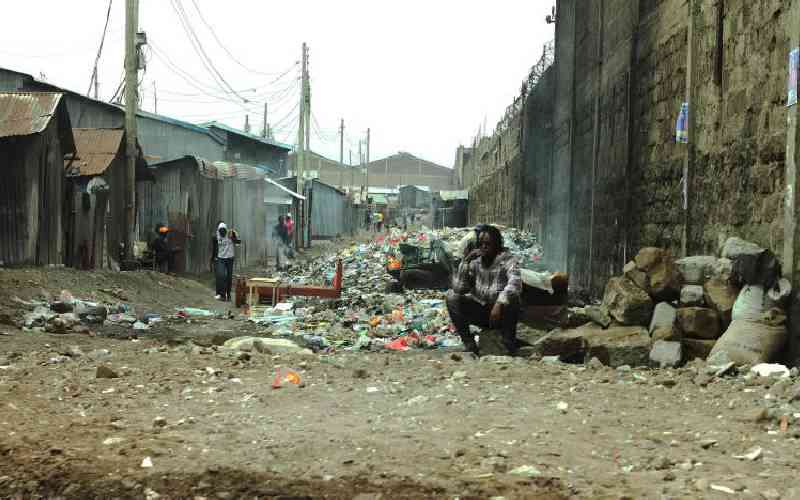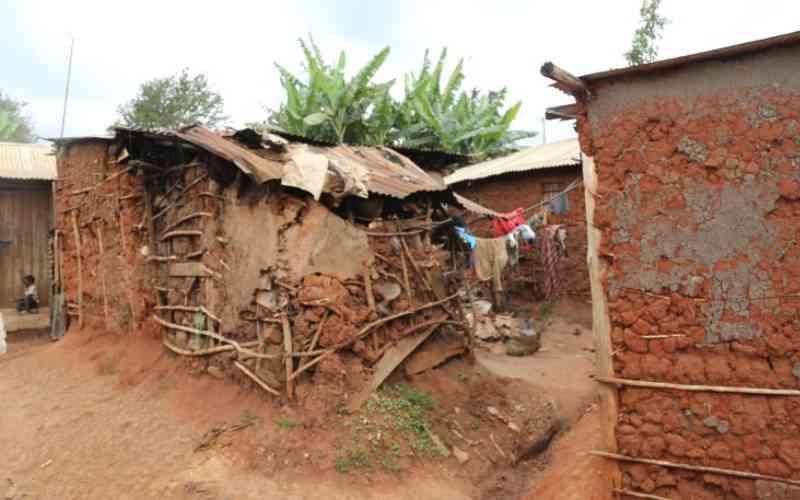
A common perception has it that beside every affluent hood is a slum. A companion; looking, lurking, feeding it and from it. Karen has the famous Kibera and beside Runda is the less known Mji wa Huruma.
But Runda and Mji wa Huruma share more than just a neighbourhood. The first residents in the slum once lived in Runda, then a coffee farm, as labourers, but were evicted in 1978.
The slums’ name, loosely translated to means Home of Mercy, was derived from the title of Nairobi’s only home for the aged — Mji wa Huruma —which borders the slum.
At the border between these unlikely neighbours, Runda and Mji wa Huruma, is a steel barricade guarded by a security officer. The irony between these two neighbours begins at the barricade, where the neat tarmac road suddenly ends and a dusty road leads into the informal settlement. Whereas Runda is neatly planned with contemporary buildings that exude splendor and sophistication; Mji wa Huruma is dotted with rusty iron-sheet shelters.
Coffee farm
Despite its inconspicuous name, Mji wa Huruma is one of Nairobi’s oldest slums. It was established in 1978 as an alternative settlement for Africans, after they were forcefully evicted from the Cheleta coffee plantation.
Cheleta was the European farmer who owned the expansive Cheleta farm, an area within which Runda estate lies today. “However, in the late 1970s, Africans who were casual labourers on the farm, would face forceful eviction after Cheleta sold it to an African enterprise,” says Kamau Thuo, MCA Karura ward, who was born and bred in Mji wa Huruma.
Thuo argues that the current residents of Mji wa Huruma are the descendants of the original natives of Runda and were permitted to live in the white man’s highlands by virtue of being servants. According to Nairobi’s initial Master Plan of 1926, the colonial government zoning ordinance provided for procedural zoning and development-control principles, which required Africans to inhabit the infertile lands of Nairobi’s Eastlands, while the colonial masters resided in the fertile lands.
Crowding, poor sanitation and unhealthy living conditions are some of the problems facing this slum.
Thuo, however, says that feasible development has been hindered as the residents have no titles to the land, which is currently owned by the Nairobi County government.
“I am currently working with the county government for a change of ownership of the land, which will spur development,” he says. Mji wa Huruma, which also borders Karura Forest, measures approximately 500 square metres and is inhabited by more than 1,500 people.
The history of Mji wa Huruma is traced back to the formation of the United Nations Environment Programme headquarters in Gigiri, Nairobi in 1972 which triggered a steady demand for affluent homes and eventually the displacement of Runda’s earliest occupants.
The eviction notice, however, did not go well with the Africans living on the farm and after a lengthy resistance, they were evicted in 1978.
It is believed that some of Mji wa Huruma’s earliest occupants, due to a population surge, moved and founded Huruma in Mathare. Runda was founded in 1972; its first phase (Old Runda) was completed between 1972 and 1980.
Stay informed. Subscribe to our newsletter
 The Standard Group Plc is a
multi-media organization with investments in media platforms spanning newspaper
print operations, television, radio broadcasting, digital and online services. The
Standard Group is recognized as a leading multi-media house in Kenya with a key
influence in matters of national and international interest.
The Standard Group Plc is a
multi-media organization with investments in media platforms spanning newspaper
print operations, television, radio broadcasting, digital and online services. The
Standard Group is recognized as a leading multi-media house in Kenya with a key
influence in matters of national and international interest.
 The Standard Group Plc is a
multi-media organization with investments in media platforms spanning newspaper
print operations, television, radio broadcasting, digital and online services. The
Standard Group is recognized as a leading multi-media house in Kenya with a key
influence in matters of national and international interest.
The Standard Group Plc is a
multi-media organization with investments in media platforms spanning newspaper
print operations, television, radio broadcasting, digital and online services. The
Standard Group is recognized as a leading multi-media house in Kenya with a key
influence in matters of national and international interest.









